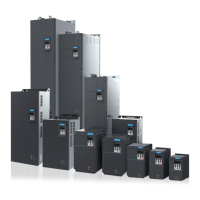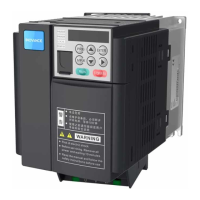Appendix B
-
148
-
unsigned int crc_chk_value(unsigned char *data_value,unsigned char length)
{
unsigned int crc_value=0xFFFF;
int i;
while
(
length--)
{
crc_value^=*data_value++;
for(i=0;i<8;i++)
{
If(crc_value&0x0001)
{
crc_value=(crc_value>>1)^0xa001;
}
else
{
crc_value=crc_value>>1;
}
}
}
return(crc_value);
}
Denition of Communication Parameter Addresses
Function parameters can be read and written (except those which cannot be changed because they are only
for the factory use or for monitoring).
B.4 Rules for Parameter Address Marking
Parameter group No. and parameter identifying No. are used to express parameter address.
High-order bytes: F0 to FF (groups F), A0 to AF (groups A), 70 to 7F (group U)
Low-order bytes: 00 to FF
For example, to read parameter F3-12, communication address of F3-12 is expressed as 0xF30C.
● Group FF: They are factory parameters. The parameters cannot be read or changed.
● Group U: These parameters can only be read.
Some parameters cannot be modied when the AC drive is running. Some parameter cannot be modied re-
gardless of status of the AC drive. In addition, pay attention to setting range, unit and description of parameters
when modifying them.
Parameter Group Visited Address Parameter Address in RAM
F0 to FE 0xF000 to 0xFEFF 0x0000 to 0x0EFF
A0 to AC 0xA000 to 0xACFF 0x4000 to 0x4CFF
U0 0x7000 to 0x70FF
● Frequent storage to the EEPROM reduces its service life. Therefore, in communication mode, users
can change values of certain parameters in RAM rather than storing the setting.
For groups F parameters, users only need to change high order F of the function code address to 0.
For groups A parameters, users only need to change high order A of the function code address to 4.
The function code addresses are expressed as follows:
High-order bytes: 00 to 0F (groups F), 40 to 4F (groups A)
Low-order bytes: 00 to FF

